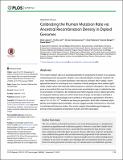Calibrating the Human Mutation Rate via Ancestral Recombination Density in Diploid Genomes
Author(s)
Lipson, Mark; Loh, Po-Ru; Sankararaman, Sriram; Patterson, Nick; Berger, Bonnie; Reich, David; ... Show more Show less
DownloadLipson-2015-Calibrating the Huma.pdf (2.430Mb)
OPEN_ACCESS_POLICY
Open Access Policy
Creative Commons Attribution-Noncommercial-Share Alike
Terms of use
Metadata
Show full item recordAbstract
The human mutation rate is an essential parameter for studying the evolution of our species, interpreting present-day genetic variation, and understanding the incidence of genetic disease. Nevertheless, our current estimates of the rate are uncertain. Most notably, recent approaches based on counting de novo mutations in family pedigrees have yielded significantly smaller values than classical methods based on sequence divergence. Here, we propose a new method that uses the fine-scale human recombination map to calibrate the rate of accumulation of mutations. By comparing local heterozygosity levels in diploid genomes to the genetic distance scale over which these levels change, we are able to estimate a long-term mutation rate averaged over hundreds or thousands of generations. We infer a rate of 1.61 ± 0.13 × 10[superscript −8] mutations per base per generation, which falls in between phylogenetic and pedigree-based estimates, and we suggest possible mechanisms to reconcile our estimate with previous studies. Our results support intermediate-age divergences among human populations and between humans and other great apes.
Date issued
2015-11Department
Massachusetts Institute of Technology. Computer Science and Artificial Intelligence Laboratory; Massachusetts Institute of Technology. Department of MathematicsJournal
PLOS Genetics
Publisher
Public Library of Science
Citation
Lipson, Mark, Po-Ru Loh, Sriram Sankararaman, Nick Patterson, Bonnie Berger, and David Reich. “Calibrating the Human Mutation Rate via Ancestral Recombination Density in Diploid Genomes.” Edited by Graham Coop. PLOS Genetics 11, no. 11 (November 12, 2015): e1005550.
Version: Final published version
ISSN
1553-7404